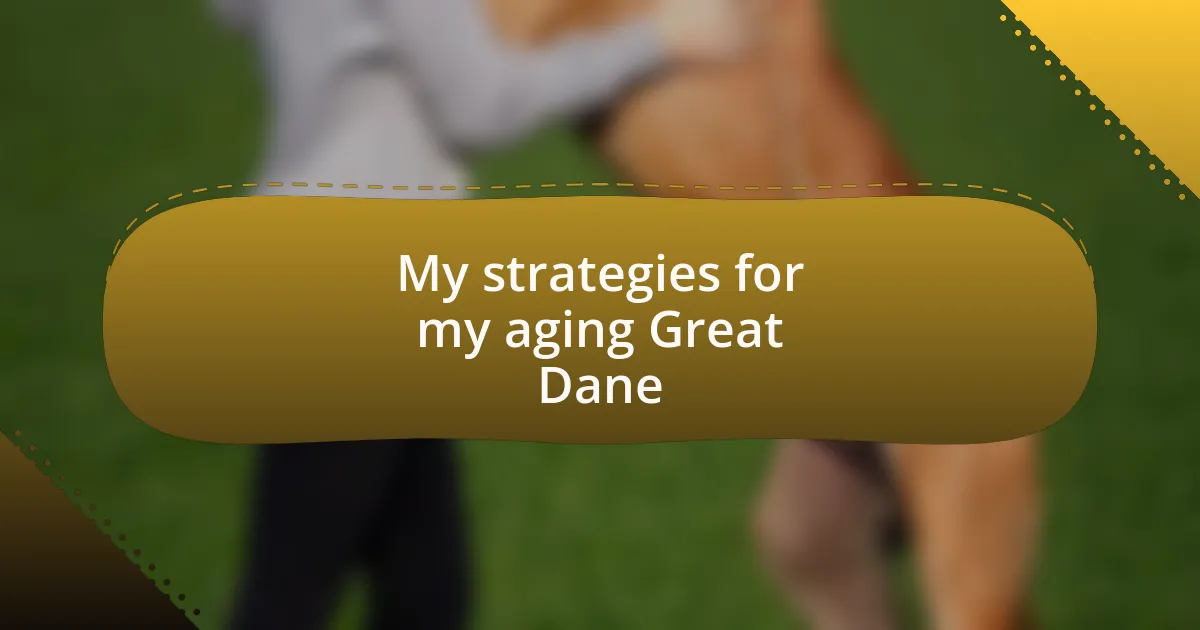Key takeaways:
- Aging in dogs involves both physical and behavioral changes, requiring owners to adapt their routines for comfort.
- Training methods should be adjusted as dogs age, using shorter sessions and softer treats to maintain engagement.
- Creating a structured daily routine and incorporating gentle physical touch can enhance the emotional bond and comfort for aging pets.
- Monitoring energy levels is crucial, as it helps to balance exercise and ensure the dog’s well-being during their golden years.
Author: Clara Ashford
Bio: Clara Ashford is an acclaimed author known for her evocative storytelling and richly drawn characters. With a background in psychology and literature, she weaves complex narratives that explore the human experience and emotional depth. Her debut novel, Whispers in the Wind, captivated readers and critics alike, earning her a place among contemporary voices in fiction. Clara resides in the Pacific Northwest, where the lush landscapes inspire her writing. When she’s not crafting her next tale, she enjoys hiking, painting, and engaging with her vibrant community of fellow writers.
Understanding aging in dogs
Aging in dogs is a gradual process that often sneaks up on us. I can still remember the day my Great Dane, Max, stopped bounding up the stairs with the same zeal he once had. It made me wonder: how do we truly gauge when our dogs are crossing into their golden years?
As they age, many dogs experience changes not just physically but behaviorally too. I noticed that Max became more hesitant during our walks, sometimes pausing to sniff a familiar tree rather than racing ahead. It’s a poignant reminder that their needs evolve, and as responsible pet owners, it’s vital to recognize these signs and adapt our routines to keep them comfortable.
Did you know that the aging process in dogs can mirror that of humans? I often reflect on how Max began to show signs of arthritis, much like how we might feel the toll of time on our bodies. Observing these changes deepened my understanding of how essential it is to provide them with not just love, but also the right care as their needs shift.
Importance of adapting training methods
Adapting training methods as our dogs age is crucial for maintaining their well-being. I remember when I realized that Max needed a slower-paced approach to learning new commands. Instead of long training sessions, I found that shorter, more frequent sessions worked wonders for his attention span and energy levels. It’s fascinating how minor adjustments can yield significant results in keeping our aging companions engaged.
I’ve also noticed that the type of reinforcement can play a pivotal role. Treats became a great motivator, but I quickly learned that they needed to be softer and more easily digestible for Max as he aged. Have you ever thought about how a simple change in approach can strengthen your bond with your dog? By being mindful of what drives them, we can foster a reassuring atmosphere that encourages them to participate rather than shy away.
Ultimately, flexibility in our training methods not only aids in effective communication but also respects the dignity of our aging dogs. I recall the first time I shifted to praise-based rewards; Max’s tail wagged with such enthusiasm, making it clear that he thrived on positive reinforcement. Each time I adjusted my methods, I witnessed not just his learning, but also a refreshing spark in his spirit, reminding me that adapting to their needs is a testament to our love and commitment.
My personal tips and experiences
As I navigated the challenges of caring for my aging Great Dane, I found that creating a structured daily routine was invaluable. By incorporating consistent meal times, walks, and play sessions, I noticed that Max responded positively, feeling more secure in his environment. Have you ever experienced how familiarity creates a sense of comfort for your dog? For me, it was a game-changer.
Not long ago, I decided to introduce gentle massage into our routine. The first time I stroked Max’s back, he let out a deep sigh of relaxation that warmed my heart. It became our special bonding time, and I could see the stress dissipate from his aging body. Have you thought about how physical touch can convey love and reassurance? This simple act not only helped with his joint stiffness but also strengthened the emotional connection between us.
While I adapted Max’s exercise regimen, I was careful to monitor his energy levels closely. I remember moments when he seemed hesitant to join me on walks, so I made a point to shorten our excursions while still embracing the outdoors. This balance taught me the importance of being observant and responsive. Do you ever find yourselves negotiating between what you want for your dog and what they truly need? This ongoing journey has been as much about listening to Max as it has been about maintaining our shared adventures.

Leave a Reply